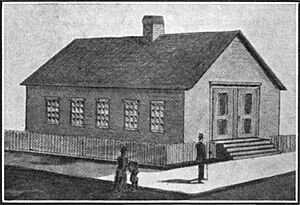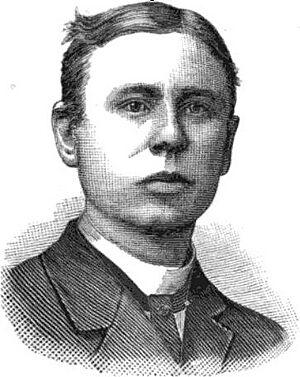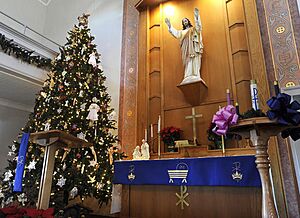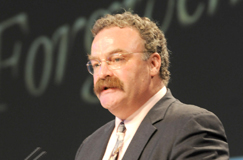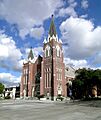Lutheran Church – Missouri Synod facts for kids
Quick facts for kids The Lutheran Church – Missouri Synod |
|
|---|---|

The LCMS logo (2020)
|
|
| Abbreviation | LCMS |
| Classification | Protestant |
| Orientation | Confessional Lutheran |
| Polity | Synodical/modified congregational |
| Structure | National synod, 35 middle level districts, and local congregations |
| President | Matthew C. Harrison |
| Altar and pulpit fellowship | American Association of Lutheran Churches Evangelical Lutheran Church of Latvia |
| Associations | International Lutheran Council |
| Region | United States, especially in the Upper Midwest. |
| Headquarters | Kirkwood, Missouri |
| Founder | C. F. W. Walther |
| Origin | April 26, 1847 Chicago, Illinois |
| Separated from | German Landeskirchen |
| Absorbed | Evangelical Lutheran Synod of Illinois and Other States (1880) Evangelical Lutheran Concordia Synod of Pennsylvania and Other States (1886) English Evangelical Lutheran Synod of Missouri and Other States (1911) Synodical Conference Negro Mission (1961) National Evangelical Lutheran Church (1964) Synod of Evangelical Lutheran Churches (1971) |
| Separations | Orthodox Lutheran Conference (1951) Lutheran Churches of the Reformation (1964) Association of Evangelical Lutheran Churches (1976), Evangelical Lutheran Church of Brazil (1980) Evangelical Lutheran Church of Argentina (1986) Lutheran Church–Canada (1988) |
| Congregations | 5,767 |
| Members | 1,674,315 baptized 1,328,392 confirmed |
| Primary schools | 822 |
| Secondary schools | 99 |
| Tax status | IRS 501(c)(3) organization |
| Tertiary institutions | 2 seminaries, 7 colleges and universities |
| Other name(s) | German: Die Deutsche Evangelisch-Lutherische Synode von Missouri, Ohio und andern Staaten German Evangelical Lutheran Synod of Missouri, Ohio, and Other States |
| Publications | The Lutheran Witness Reporter |
The Lutheran Church – Missouri Synod (LCMS), also known as the Missouri Synod, is a large Christian church group in the United States. It is a type of Lutheran church that follows traditional beliefs. As of 2023, it had about 1.7 million members, making it the second-largest Lutheran group in the U.S. The LCMS was started in 1847 in Chicago. Its original name was the German Evangelical Lutheran Synod of Missouri, Ohio, and Other States. This name showed where its first churches were located.
The LCMS has churches in all 50 U.S. states and two Canadian provinces. More than half of its members live in the Midwest. The main office of the LCMS is in Kirkwood, Missouri, near St. Louis. The church is divided into 35 areas called districts. Most of these districts cover specific geographic areas. The current president of the LCMS is Matthew C. Harrison, who started his role in 2010.
Contents
History of the LCMS
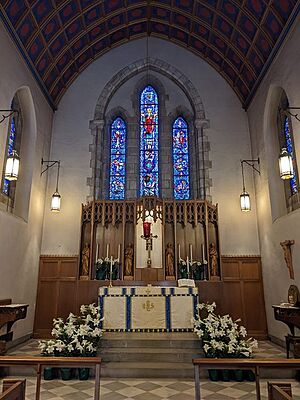
How the LCMS Started
The Missouri Synod began with groups of German Lutheran immigrants in the 1830s and 1840s. These immigrants came to places like Indiana, Ohio, and Michigan. A missionary named F. C. D. Wyneken helped bring isolated German families together.
Another group of Lutherans came from Saxony in Germany. They were led by Bishop Martin Stephan. They settled in Perry County, Missouri, and St. Louis. In Michigan and Ohio, missionaries sent by Wilhelm Löhe helped start German Lutheran communities. These included Frankenmuth, Michigan, and other areas in Michigan.
Saxon Immigrants' Journey
In the 1800s, some Lutherans in Germany felt their church was changing in ways they disagreed with. They wanted to practice their faith exactly as described in the Book of Concord. So, in November 1838, Martin Stephan and about 600 to 700 other Saxon Lutherans left Germany for the United States.
They arrived in New Orleans in late 1838 and early 1839. One ship was lost at sea. Most immigrants quickly moved on, arriving in St. Louis by January 1839. They eventually settled in Perry County, Missouri, and around St. Louis. Martin Stephan was their first leader, but he was later removed. C. F. W. Walther then became the leader of the group.
Löhe's Missionaries
Starting in 1841, a pastor named Wilhelm Löhe in Germany began helping German immigrants in North America. He raised money and trained people to become pastors and teachers. He sent his first two students to America in 1842. Löhe sent over 80 pastors and students in total. These pastors started churches in Ohio, Michigan, and Indiana.
Löhe also tried to send missionaries to Native Americans. In 1845, he sent colonists to Michigan to start a German Lutheran settlement. This settlement was meant to be a base for missionary work. They founded villages like Frankenmuth. However, their efforts to convert Native Americans had limited success.
Löhe also helped start Concordia Theological Seminary in Fort Wayne, Indiana. He raised money and sent students and a professor from Germany. The first president of the seminary, Wilhelm Sihler, was also sent by Löhe. C. F. W. Walther, the first president of the LCMS, said that Löhe was like a "spiritual father" to the Synod because of his great help.
Starting the Synod

In 1844 and 1845, the Saxon Lutherans, Löhe's missionaries, and other pastors began talking about forming a new church group. On April 26, 1847, twelve pastors from fourteen German Lutheran churches met in Chicago. They officially started the German Evangelical Lutheran Synod of Missouri, Ohio and Other States. Walther became its first president.
The new synod quickly became known for its traditional and strict beliefs. Its rules required all members to agree with the entire Book of Concord. They also had to reject mixing different church beliefs. This meant that they usually only shared communion and pulpits with other Lutheran churches that fully agreed with their teachings.
The LCMS grew quickly in its early years. This was largely because it helped German immigrants find homes, build churches and schools, and train pastors and teachers. By 1888, it had become the largest Lutheran church group in the United States. By 1897, the synod had grown to 687,000 members.
Working with Other Lutherans
From 1856 to 1859, the Missouri Synod held meetings to see if they could work with other traditional Lutheran groups. In 1872, the LCMS joined with the Norwegian Synod, Wisconsin Synod, Ohio Synod, Minnesota Synod, and Illinois Synods. They formed the Evangelical Lutheran Synodical Conference of North America.
Over time, the LCMS started to use more English in its services. This was especially true during the early 1900s. Older members still spoke German, but younger members were switching to English. During the World Wars, anti-German feelings sped up this change. Many churches added English services or stopped German services completely. During this time, the synod's membership continued to grow, reaching over 1.5 million members by 1947.
The LCMS also expanded its outreach. It started its own radio station, KFUO (AM), in 1924. In 1930, it began an international radio program called The Lutheran Hour. Later, in 1952, the synod started its own TV drama, This Is the Life.
Changes After World War II
In 1947, the church shortened its name to "The Lutheran Church – Missouri Synod." The LCMS continued to grow, reaching its highest membership of almost 2.8 million in 1970.
In the 21st century, the LCMS has focused more on defending its traditional beliefs. This is a shift from its earlier focus on mission work.
LCMS Missions Around the World
The LCMS began sending missionaries to Brazil in 1900 to help German-speaking immigrants there. In 1904, they created the Brazil District. Work also started in Argentina in 1905. These districts later became independent churches, the Evangelical Lutheran Church of Brazil (1980) and the Evangelical Lutheran Church of Argentina (1988). Both still have close ties with the LCMS.
The LCMS also had many churches in Canada. In 1988, these churches became a separate group called Lutheran Church-Canada. This was an administrative change, not a change in beliefs. The two groups still work closely together.
What the LCMS Believes
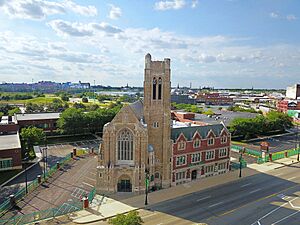
Main Teachings
A key teaching of the Lutheran Reformation is Sola scriptura, which means "Scripture alone." The LCMS believes the Bible is the only guide for church teachings. They also believe the Bible is best understood through the Book of Concord. This book contains faith statements adopted by Lutherans in the 1500s. LCMS pastors and churches agree to teach in line with the Book of Concord because they believe it faithfully explains God's Word.
The Missouri Synod also teaches biblical inerrancy. This means they believe the Bible is inspired by God and has no errors. Because of this, they do not agree with many modern liberal ways of studying the Bible.
Salvation
The LCMS teaches that salvation comes from God's grace alone, through faith alone, because of Christ alone. They believe that Jesus is the center of the Bible. Faith in Jesus is the only way to get eternal life. The synod teaches that salvation comes only from Christ's death and resurrection.
God's Gifts of Grace
The synod teaches that God's Word (both written and preached) and the Sacraments are ways God gives grace. Through these, the Holy Spirit gives God's grace, creates faith, forgives sins, and grants eternal life. Many LCMS Lutherans define a sacrament as something Jesus started that combines a promise from God's Word with a physical element. Baptism and Communion are always considered sacraments. Confession and absolution (being forgiven for sins) is also seen as a sacrament by many because Christ started it and it has His promise of grace.
Communion Beliefs
Regarding the Eucharist (Holy Communion), the LCMS believes in the doctrine of the sacramental union. This means that the Body and Blood of Christ are truly present "in, with, and under" the bread and wine. This is sometimes mistakenly called "consubstantiation," but Lutherans reject that term. They believe it's a holy mystery.
End Times Beliefs
The Missouri Synod believes in amillennialism. This means they do not believe there will be a literal 1000-year earthly kingdom of Jesus. Instead, they believe the "thousand years" in the Bible refers to Christ's current reign as king from heaven since His ascension.
Law and Gospel
The LCMS believes the Bible has two main teachings: Law and Gospel. The Law shows what God demands and how people cannot perfectly obey it because everyone is a sinner. This means the Law shows people their need for God's help. The Gospel, on the other hand, is God's promise of free salvation to sinners. The Law shows sin, but the Gospel saves. Both are gifts from God. The Law helps people see their sinful nature and leads them to the Gospel, where forgiveness is promised through Jesus Christ.
The LCMS believes both the Old Testament and the New Testament contain Law and Gospel. The Old Testament points forward to Christ's Cross, and the New Testament looks back to it.
Other Teachings
Creation
The LCMS officially supports creationism, believing that God created heaven and earth as described in the Bible, especially in Genesis 1 and 2, in six days. However, the LCMS website states that a person's personal views on the Earth's exact age do not prevent them from being a member.
Freemasonry
The LCMS believes that the teachings of Freemasonry go against the Gospel. Therefore, it tells its pastors and members to avoid joining or taking part in it.
Baptism and Other Practices
The LCMS practices infant baptism, based on Bible passages like Acts 2:38–39. They follow the Apostles' Creed, the Ten Commandments, and the Lord's Prayer as guides for daily life. These teachings are highlighted in Luther's Small Catechism.
Practices of the LCMS
Worship and Music
The LCMS believes in having worship services that are in harmony with the Bible and Book of Concord. Worship in LCMS churches is usually traditional and liturgical. This means they use a printed order of service and hymnal. Music is often played on a pipe organ or piano. LCMS hymnals, like Lutheran Service Book, show the synod's focus on traditional hymns and worship styles.
Some churches have started using more modern worship styles. This might include contemporary Christian music with guitars and praise bands. They might project song lyrics onto screens instead of using hymnals. The LCMS states that it welcomes the best of both old and new musical traditions in worship, focusing on congregational singing.
Receiving Communion
The LCMS practices closed communion. This means they usually share the Eucharist (Holy Communion) only with people who are baptized and confirmed members of an LCMS church or a church that has full agreement in beliefs with the LCMS. Visitors are often asked to talk with the pastor before receiving communion for the first time. Most churches invite those who are not ready for communion to come forward for a blessing instead.
Becoming a Pastor
Becoming a pastor in the LCMS is seen as a public way of recognizing that a man has received a special calling from God. LCMS pastors usually need a four-year bachelor's degree and a four-year Master of Divinity degree. These degrees are often earned at Concordia Seminary in St. Louis or Concordia Theological Seminary in Fort Wayne, Indiana. Training includes studying church history, Biblical languages (Greek and Hebrew), practical skills like preaching, and church teachings.
Role of Women in the Church
The Missouri Synod teaches that only men can be ordained as clergy (pastors). However, the role of women in the church is still discussed. In 1969, women were allowed to vote in LCMS churches. In 2004, the synod confirmed that women can hold other church offices as long as these roles do not involve the specific duties of a pastor. So, in some LCMS churches, women serve as church presidents or chairpersons. Some traditional Lutherans disagree with women reading lessons or helping with communion during worship.
Interfaith Services
The LCMS does not allow its clergy to worship with other faiths. They believe that joining with church groups that have different beliefs is not in line with what the Bible teaches about church fellowship. For example, an LCMS pastor in Connecticut apologized for participating in an interfaith prayer vigil after a school tragedy. Another pastor in New York was suspended for praying at an interfaith vigil after the September 11 attacks.
LCMS National Youth Gathering
The National Youth Gathering is a big event held every three years for young people in the LCMS. The most recent gathering happened from July 9–13, 2022, in Houston. Its theme was "In All Things." The 2019 gathering was in Minneapolis, Minnesota, with the theme "Real. Present. God." About 25,000 young people attend each gathering. Many Christian bands and artists perform there.
How the Church is Organized
The LCMS has a structure where local churches have a lot of say, but they also work together as a larger group. It is divided into 35 districts. Each district has a president who oversees the churches in that area, similar to a bishop in other church traditions. However, decisions made by the larger synod or districts are not forced on local churches if they don't agree with the Bible or are not practical for that church.
The LCMS is made up of two types of members: local churches that agree to follow the rules, and clergy (pastors) who also agree. Local churches own their buildings and property. They also hire and dismiss their own pastors. This structure allows churches to work together on big projects, like mission work in other countries.
The Synod as a Whole
The entire LCMS is led by an ordained president, currently Matthew C. Harrison. The president is chosen at a synodical convention. This is a meeting of clergy and representatives from member churches. The convention happens every three years. During these events, they discuss beliefs and policies, and hold elections for various positions. The latest LCMS convention took place in 2023 in Milwaukee, Wisconsin.
Presidents of the LCMS
- 1847–1850 Carl Ferdinand Wilhelm Walther
- 1850–1864 Friedrich Conrad Dietrich Wyneken
- 1864–1878 Carl Ferdinand Wilhelm Walther
- 1878–1899 Heinrich Christian Schwan
- 1899–1911 Franz August Otto Pieper
- 1911–1935 Friedrich Pfotenhauer
- 1935–1962 John William Behnken
- 1962–1969 Oliver Raymond Harms
- 1969–1981 Jacob A. O. Preus II
- 1981–1992 Ralph Arthur Bohlmann
- 1992–2001 Alvin L. Barry
- 2001–2001 Robert T. Kuhn
- 2001–2010 Gerald B. Kieschnick
- 2010–present Matthew C. Harrison
Districts of the LCMS
The synod is divided into 35 districts. Thirty-three of these cover specific geographic areas. The other two, the English and the SELC, are not based on location. Each district is led by an elected district president, who must be an ordained pastor. Most district presidents work full-time in this role. Districts are similar to dioceses in other Christian groups.
Local Churches
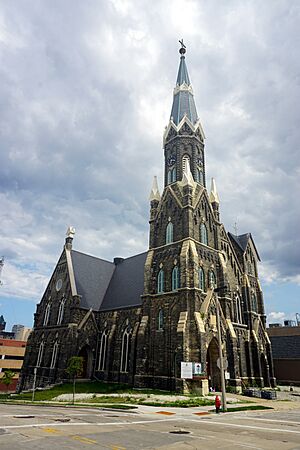
Most local churches have full-time pastors. Some churches, especially in rural areas, have pastors who also work other jobs to support themselves.
Organizations and Education
Schools and Universities
Besides its two seminaries (schools for training pastors), the LCMS runs seven universities. These are part of the Concordia University System.
Other Groups
The LCMS has other important groups that help with its work. The Lutheran Laymen's League, now called Lutheran Hour Ministries, runs outreach programs like The Lutheran Hour radio show. The Lutheran Women's Missionary League also supports missions. The synod also has Concordia Publishing House, which publishes its official magazine, The Lutheran Witness, and newspaper, Reporter.
The LCMS also has the LCMS Foundation for financial support and the Lutheran Church Extension Fund. This fund provides loans to LCMS churches, organizations, and workers.
Relationships with Other Lutheran Churches
The LCMS is a traditional church group that believes in full agreement on Bible teachings. Because of this, it is not part of most large groups that bring different Christian churches together, like the National Council of Churches or the World Council of Churches. However, it is a member of the International Lutheran Council (ILC). This group includes over 50 Lutheran churches worldwide that support traditional beliefs from the Bible and the Augsburg Confession.
In 2007, the LCMS agreed to have altar and pulpit fellowship with the American Association of Lutheran Churches (AALC). This means they share communion and pulpits.
The LCMS is different from the Wisconsin Evangelical Lutheran Synod (WELS), another traditional Lutheran group, in a few ways:
- Understanding of Fellowship: The LCMS believes there's a difference between sharing communion/pulpits and other types of Christian fellowship (like praying together). The WELS does not make this distinction.
- Role of Pastors: The LCMS believes the role of a pastor is directly from God, but other church roles are human creations. The WELS believes that the ministry of the Word is from God, and churches can choose how they organize public ministry.
- Women's Roles: Both the LCMS and WELS agree that only men can be pastors. However, the WELS also believes the Bible forbids women from voting in church meetings or serving on church councils.
Membership and Demographics
The LCMS grew a lot in the first half of the 1900s. In 1925, it had about 628,695 members. By 1950, this number grew to over 1.6 million. Membership reached its highest point in 1970 with almost 2.8 million members. In 2020, the LCMS reported 1,861,129 members and 5,976 churches. LCMS members are mostly found in the Upper Midwest of the United States. The states with the most members are Nebraska, Wisconsin, South Dakota, Minnesota, and Iowa.
Images for kids
-
Zion Lutheran Church in Cleveland, Ohio
-
St. John's Lutheran Church in Orange, California
See also
 In Spanish: Iglesia luterana Sínodo de Misuri para niños
In Spanish: Iglesia luterana Sínodo de Misuri para niños


